Researchers have found that the Zika virus is transmitted from mother to a foetus by infected cells that will later go on to develop into the brain’s first and primary form of defence against the invasive pathogens.
“It’s a Trojan Horse strategy. During embryogenesis — the early stages of prenatal development — cells called microglia form in the yolk sac and then disperse throughout the central nervous system of the developing child,” said Alysson Muotri, professor at the University of California – San Diego.
Advertisement
In the brain, these microglia will become resident macrophages whose job is to constantly clear away plaques, damaged cells and infectious agents.
However, considering the timing of transmission, the researchers hypothesised that microglia might be serving as a Trojan horse to transport the virus during invasion of the central nervous system.
“Our findings show that the Zika virus can infect these early microglia, sneaking into the brain where they transmit the virus to other brain cells, resulting in the devastating neurological damage we see in some newborns,” Muotri added.
For the study, published in the journal Human Molecular Genetics, the team used human induced pluripotent stem cells to create two relevant central nervous system cell types: microglia and neural progenitor cells (NPCs) and examined their interactions in vitro when exposed to the Zika virus.
The researchers found that the microglia cells engulfed Zika-infected NPCs, doing their job.
But when these microglia carrying the virus were placed in contact with non-infected NPCs, they transmitted the virus to the latter.
“That suggests microglia may indeed be the culprit for transmitting the virus to the central nervous system during prenatal neurodevelopment,” Muotri noted.
The researchers suggests that microglial cells could be a therapeutic target for reducing Zika transmission into the central nervous system of developing foetuses.











